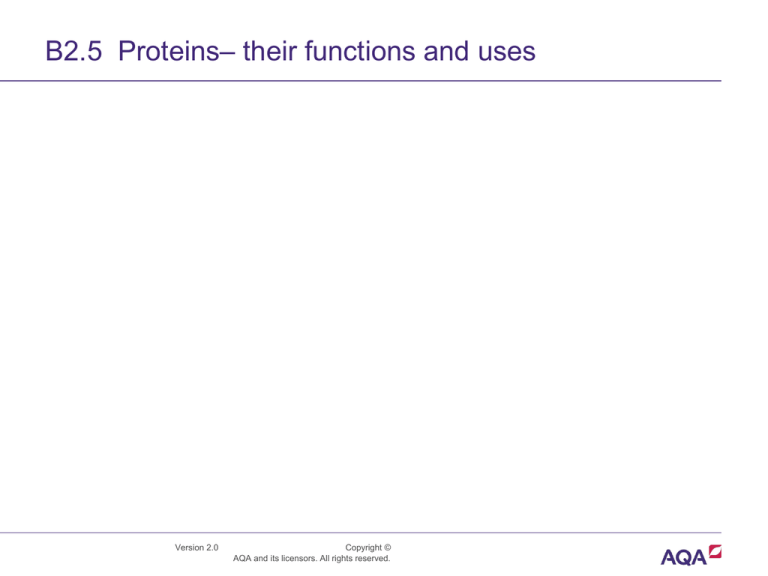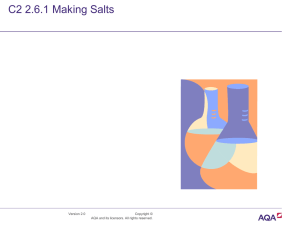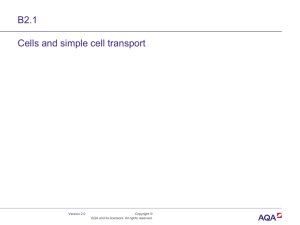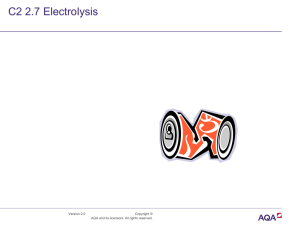
B2.5 Proteins– their functions and uses
Version 2.0
Copyright ©
AQA and its licensors. All rights reserved.
•
B2.5 Proteins– their functions and uses
BL2FP June 2012
The diagram shows the human digestive system
Heartburn is a burning feeling caused when acid enters the oesophagus. The
acid comes from the stomach.
(i) Which letter on the diagram shows the stomach? (1 mark)
(ii) Name the acid the stomach produces. (1 mark)
(iii) Medicines taken to treat heartburn contain chemicals that neutralise excess
stomach acid. What type of chemical will neutralise stomach acid?
• (1 mark)
Version 2.0
Copyright © AQA and its
licensors. All rights reserved.
•
B2.5 Proteins– their functions and uses BL2FP June 2012
(b) Use words from the box and your own knowledge to describe
how carbohydrates are digested.
………………………………………………………………………
……………………………….
………………………………………………………………………
………………………………..
………………………………………………………………………
……………………………….
………………………………………………………………………
………………………………..
………………………………………………………………………
………………………………..
( 5 marks)
(c) Where in the body are the products of digestion absorbed?
........................................................................................................
Version 2.0
Copyright © AQA and its
licensors. All rights reserved.
•
Version 2.0
B2.5 Proteins– their functions and uses BL2FP June 2012 mark scheme
Copyright © AQA and its
licensors. All rights reserved.
Exampro QSP 2H 08
8
The diagram shows the apparatus used to investigate the digestion of milk fat by an
enzyme. The reaction mixture contained milk and the enzyme.
In Experiment 1, bile was also added.
In Experiment 2, an equal volume of water replaced the bile.
In each experiment, the pH was recorded at 2 minute intervals.
Version 2.0
Copyright © AQA and its
licensors. All rights reserved.
The results of the two experiments are given in the table.
pH
Time in
Experiment 1: with bile
Experiment 2: without bile
minutes
8
(a)
0
9.0
9.0
2
8.8
9.0
4
8.7
9.0
6
8.1
8.8
8
7.7
8.6
10
7.6
8.2
Milk fat is a type of lipid.
Explain why the pH changed in experiment 2.
…………………………………………………………………………………………………
…………………………………..
…………………………………………………………………………………………………
…………………………………..
Version 2.0
Copyright © AQA and its
licensors. All rights reserved.
…………………………………………………………………………………………….........
8
(b)
(i) For Experiment 1, calculate the average rate of fall in pH per minute,
between
4 minutes and 8 minutes.
Show clearly how you work out your final answer.
…………………………………………………………………………………………………
…………………………………..
8
…………………………………………………………………………………………………
………… pH units per minute
(2 marks)
(b)
(ii) The average rate of fall in pH per minute for Experiment 2 was 0.1 units of
pH per minute.
Explain the difference in the rate of fall in pH when bile is present.
…………………………………………………………………………………………………
…………………………………..
Version 2.0
Copyright © AQA and its
licensors. All rights reserved.
…………………………………………………………………………………………………
question
8(a)
answers
the enzyme must be lipase
extra information
since fatty acid produced, which
lowered the pH
8(b)(i)
mark
1
1
0.25 or
correct answer with / without
working
1
4
if answer incorrect / missing, then
evidence of
gains
8
.
7
7
.
7
1 mark
4
8(b)(ii)
bile provides optimum / suitable /
best pH for enzyme action
therefore the rate of the reaction
increased
Total
1
5
Version 2.0
Copyright © AQA and its
licensors. All rights reserved.
Exampro Q08s 2H 07
1 Enzymes are used in biological detergents.
1 (a) Name the type of enzyme that digests stains containing fats.
.............................................................................................................................................
(1 mark)
1 (b) A new detergent is marketed as being ‘environmentally-friendly’.
Scientists compared the performance of this new detergent with an existing detergent.
They measured the time taken by the two detergents to remove a fat stain at different
temperatures.
The graph shows their results.
Version 2.0
Copyright © AQA and its
licensors. All rights reserved.
1 (b) (i) Describe the effect of increasing the temperature on the time taken by the
existing detergent to remove the stain.
…………………………………………………………………………………………………
…………………………………..
…………………………………………………………………………………………………
…………………………………..
…………………………………………………………………………………………….........
......................................
(2 marks)
1 (b) (ii) The new detergent works at a lower temperature than the existing one.
Is the new detergent likely to be more ‘environmentally-friendly’ than the
existing detergent?
Draw a ring around your answer. Yes / No
Explain the reason for your answer.
…………………………………………………………………………………………………
Version 2.0
Copyright © AQA and its
…………………………………..
licensors. All rights reserved.
1 (c) Neither detergent works well at 60 °C.
Explain why.
…………………………………………………………………………………………………
…………………………………..
…………………………………………………………………………………………………
…………………………………..
…………………………………………………………………………………………….........
......................................
(2 marks)
Version 2.0
Copyright © AQA and its
licensors. All rights reserved.
Version 2.0
Copyright © AQA and its
licensors. All rights reserved.
Version 2.0
Copyright © AQA and its
licensors. All rights reserved.











